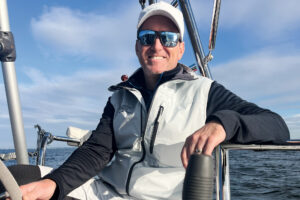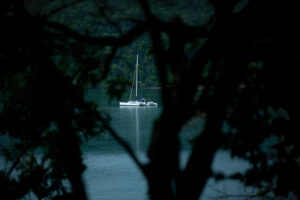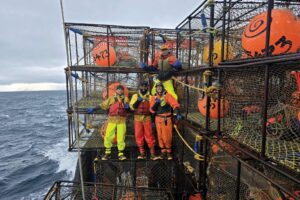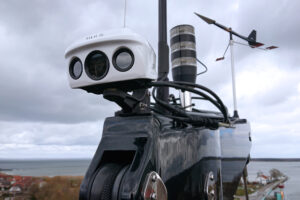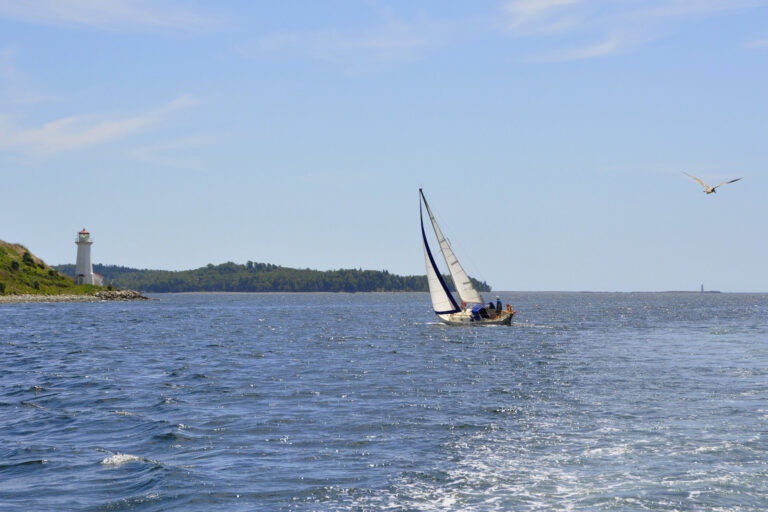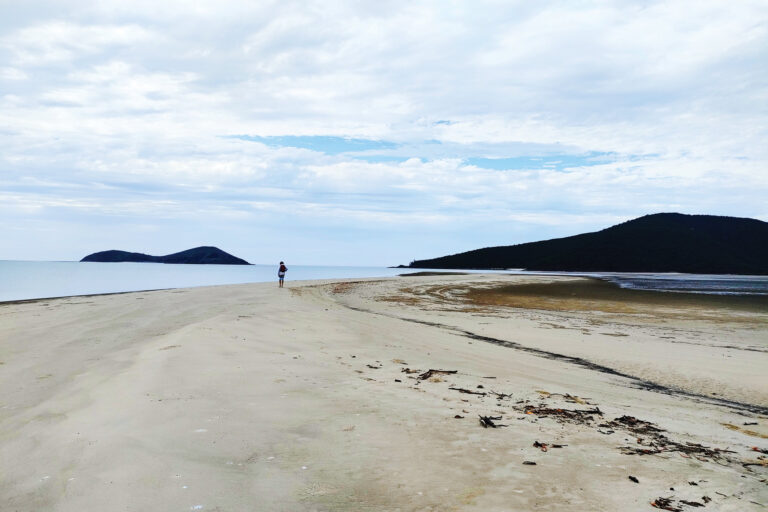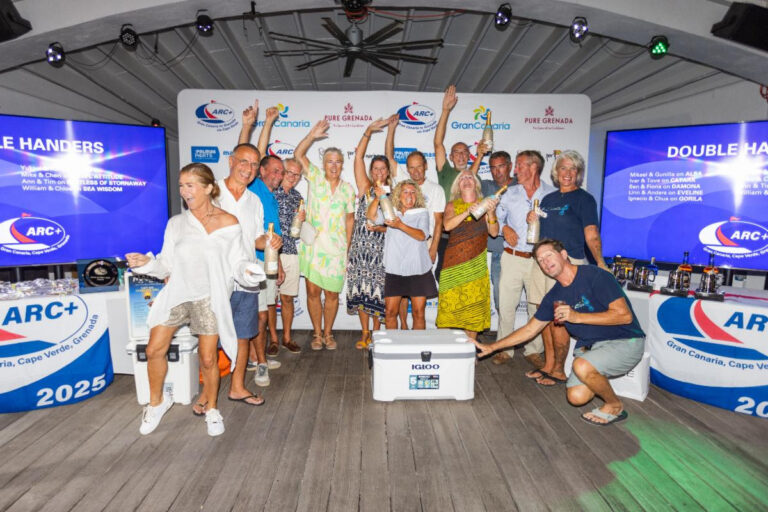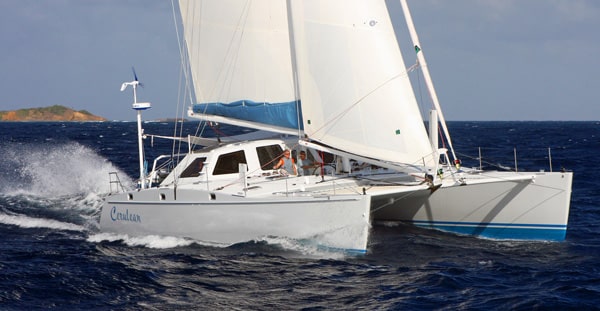
Go sailing with one of the world’s top cruising-multihull designers on his brand-new creation and you learn a few things. Such as why the state of cruising-cat design is where it is today. And why a cruising multi has to be built light-but not too light. And why a cruising cat can shine as a fuel-efficient “powerboat” as well. And why a successful cruising catamaran is all about balancing design elements-making the right compromises in the right places and in the right amounts. And, as I discovered during a day with cat designer and advocate Chris White, you’ll learn about not only yacht design but also the designer.
In a building sea breeze, we’re short-tacking Lely, a cutter-rigged, composite-built Atlantic 57, through East Passage, in Rhode Island’s Narragansett Bay. Chris White is at the carbon-fiber wheel, steering with two fingers and looking up to check the mainsail trim. During the tacks, I pop the daggerboards up and down as the self-tacking staysail flips across and the battens of the big, high-aspect mainsail rumble over. When the sails fill, Lely, unburdened by the 15,000-or-so pounds of ballast of a similarly sized monohull, jumps forward. The sudden acceleration, a signature move of performance cats, rocks each of us back on our heels for a second. For most single-hulled sailors, this sensation is unsettling, if not downright subversive. I glance over at White. For the first time during a day of sea-trialing, he’s allowed a thin smile to play over his face, the kind of look that says: I’m satisfied. Almost.
For the 52-year-old White, who for 28 years has been drawing performance-cruising multihulls that not only reach and run fast but also sail to windward, being almost satisfied is part of the balancing act of designing a modern cruising cat. Lely, an evolution of White’s Atlantic 55 (half-a-dozen 55s have been built, including White’s own boat, Javelin), embodies that balance. Lely is light and stiff, strong where she needs to be, and beautiful where you’d like her to be. On deck, she bristles with raceboat-worthy sailhandling gear. Belowdecks, she is, unmistakably, a luxury yacht-the vertical-grain and plain-sawn cherry joiner work gleams under coats of high-gloss varnish. So, you might wonder, where are all the compromises in Lely’s balancing act?
A large cruising cat such as Lely is a seemingly unlimited canvas for all your cruising dreams: a sailhandling cockpit, a wide “back porch” for lounging, the enticing layout possibilities of two hulls, and enough deck space for your fleet of water toys. Lely boasts a whopping 1,052 square feet of usable living space, which is about a 68-percent increase over the 625 square feet you’ll find in a contemporary 57-foot, center-cockpit monohull. Still, in terms of systems, Lely seems to have it all: separate 12-volt-DC and 24-volt-DC electrical circuits and 120-volt and 220-volt shore power (220-volt AC makes for easy plug-in while cruising in the Med, among other places); a 920-amp-hour battery bank; a Fischer Panda ACG 4000 genset; air-conditioning and diesel-fired forced-air heat; a Spectra Newport 400 watermaker (it makes 17 gallons per hour); and a large fridge/freezer, freshwater electric toilets, saltwater deck-washdown gear, and a full suite of navigation and communication electronics. The only modern convenience “missing” is a washer/dryer-and, yes, there’s plenty of room to add one. But in the interests of saving weight and reducing complication-two areas over which Chris White agonizes-a washer/dryer may be one of those temptations you should do your best to resist. As Chris will be the first to tell you, if you fill up a cat’s spaces with endless amounts of “stuff,” you’ll sink the performance to that of an ordinary monohull.
The first step toward making sure that the finished Lely would stay cat fast came with her construction:
epoxy resin, triaxial E-glass, and Core-Cell and AirLite foams. But even with weight-efficient building materials, given Lely’s nearly 3,000 square feet of hull, deck, bridgedeck, and cabin-house panels, plus numerous bulkheads and three main crossbeams, incremental increases in weight can add up quickly. Builder Aquidneck Custom Composites used vacuum bagging and an impregnator to control the resin-to-glass ratio and keep the weight down (at 25,500 pounds, the boat is lighter than many 44-foot production cats). Aquidneck Custom Composites’ Bill Koffler and Scott O’Donnell, drawing on 30 years of high-end composite raceboat-construction experience between them, made Lely’s laminate not only light and strong but also, in places, elegant. “We try to eliminate metal wherever we can,” says Koffler. “Metal is heavy, and it’s prone to rust and corrosion and to leaks at attachment points.” Thus Lely sports curving, translucent, bonded-in engine mounts; fuel-filter and steering-cable brackets; and even dorade vents made of biaxial E-glass and formed from male molds-cool!
The construction also features carbon-fiber crossbeam flanges and longitudinal bands of carbon in the hulls. So rather than winding up an overweight, overstuffed creature, a cat in name only, Lely exemplifies the new breed of cruising cat: light, powered up, yet lacking nothing in the way of bells and whistles. “In the 1970s and 1980s, the yachting establishment considered multihullers to be the ‘bad boys,'” notes Chris White. “Those guys didn’t want to pay attention, they didn’t want to try new things. It’s taken many years to overcome the ‘multis break, multis turn over’ mindset.” The shift to grudging acceptance began with cats designed and built for the charterboat industry-boats that traded performance for sleeps-and-drinks-a-crowd appeal. White dismisses such boats as, well-let’s just call them “chartermarans,” and he makes the point that cats that are truly designed and built for cruising have moved beyond the charter-cat formula. White’s Atlantic series of cruising cats (measuring 42, 48, and 55 feet LOA) are notable for holding steadfastly to his long-held design tenets. The hulls are slender instead of plump (Lely, for example, has a 12:1 waterline length-to-beam ratio; many charter cats are around 9:1). No hull bump outs, steps, chines, or bulges make an appearance to indulge the accommodations. And the height of the bridgedeck, crucial to minimize wave slap in a seaway, is generous: Lely has a whopping three and one-half feet of above-water clearance.
And, of course, there’s weight. The immutable law of multihull design? Lighter is faster. But isn’t it possible to build a cruising cat too light? “There is such a thing as too light,” says White. “Extremely light racing multis are less stable and less durable, and their motion can be violent. A cruising cat, by nature, is in a different category. By the time you get all the machinery and cruising payload aboard, you’re set up for comfortable ocean cruising. But if the boat is built heavy or overloaded, at some point the top end-the ability to surge beyond 12 knots and sail consistently at 14, 16, 18 knots-will disappear. The sail area-to-displacement ratio of a cat is critical. If you cram more and more stuff into the boat without regard for weight, you’ll pay a performance penalty.”
These are things that White knows from experience, because he’s not only drawn his own boats but also built a few of them. In 1972, at the age of 18, he designed his first multihull, a 31-foot trimaran named Shadowfax, and built it himself-right there in his parents’ driveway. For the next two years, White cruised his engineless tri in Caribbean and South American waters, all the while pondering how to design a trimaran that would be better suited to ocean sailing. Upon returning to the States, he began studying yacht design in earnest, first through mail-order courses, then by working for other designers. In 1981, he and his wife, Katie, put together Juniper, a 52-foot ketch-rigged, cedar/epoxy trimaran, and with their growing family sailed the boat from Nova Scotia to the Caribbean. More recently, White has cruised aboard Javelin, his Atlantic 55, from South Africa to Guatemala, then home to Buzzards Bay, Massachusetts. Firsthand liveaboard and bluewater experience-when it starts to blow and it’s just you and your wife and two boys crossing an ocean-has a way of bringing a dose of reality to the drawing board.
Under sail, Lely feels right: The boat reacts quickly to puffs, and the steering is sensitive and light. The biggest departure from other cats is, of course, the forward cockpit, which White first developed in 1983 for one of his 50-footers. “The awkwardness of trying to sail a boat from behind a 7-foot-high bulkhead just felt wrong to me,” White explains. So he placed the wheel and sailhandling zone forward of the house, right behind the mast, and he hasn’t looked back. In 10 knots of wind, Lely sails to windward under staysail and mainsail at 7.2 knots; with the masthead genoa rolled out, she reaches at 10 to 11 knots in about 14 knots of wind. White has subsequently taken the boat upwind in 30 knots of breeze; under staysail and single-reefed mainsail, he reports that the boat sailed at 13.5 knots. For shorthanded cruisers, the cutter rig is a natural; unroll the genoa in light air and off the wind, drop down to the staysail when the breeze picks up.
Lely sports “belly fins” that are 9 feet long by 1 foot deep (measured from the hull body); these spare the hull from damage during a grounding, and they’ll also support the boat’s weight on the beach or at the boatyard. Unlike many other cruising catamarans, Lely has deep, foam-filled, asymmetric daggerboards that provide lift when sailing upwind. Deep daggerboards (or centerboards) are central to White’s insistence that a multihull should sail to windward as well as or better than a monohull.
For downwind work, Lely has an asymmetric cruising spinnaker; other cruising cats, including many Atlantic 55s, use a screecher flown from a bowsprit prod. Harken electric-powered main halyard/mainsheet and traveler/runner winches and a plethora of sailhandling gear will help tame the large sail loads; the 933-square-foot mainsail, for example, demands respect.
Lely’s cockpit-forward steering and sailhandling layout is closely linked to the 16-foot-wide bridgedeck pilothouse. Accessible through a weatherproof cockpit door and a sliding door aft, the bridgedeck combines an inside steering station with 360-degree visibility, a navigation/computer workstation area, and a saloon with a dinette table and a lounging area laid around a jazzy little cocktail table. The pilothouse zone, in addition to keeping the person on the helm warm and dry when it’s cold and wet outside, allows Lely to function rather nicely as a powerboat. With the twin 54-horsepower Yanmar diesels turning over at 2,500 rpm and burning about a gallon an hour, Lely moves along at 10 knots; the boat cruises at 8 knots on one engine alone. Compare that with, say, a 47-foot trawler, which needs a 174-horsepower diesel burning 6 gallons an hour just to make 8 knots. Now, which boat is the better powerboat? Need we even mention that, with its wide wheelbase, a cat doesn’t roll under power?
Lely’s accommodation plan, with identical master cabins each having a roomy vanity, head, and toilet area amidships in each hull, maximizes privacy. The galley, with a 9.3-cubic-foot fridge and 7-cubic-foot freezer, stretches for 9 feet in the starboard hull, adjacent to the bridgedeck stairway. In the same location in the port hull, the owner’s pride and joy: a stainless-steel workbench, vise, lots of tool drawers, and a slide-out toolbox. Aft, both hulls feature a double berth with a dresser, seat, and hanging locker. The forward 16 feet of each hull (with two collision bulkheads) is largely empty-the right place to stow such bulky, sometimes-damp gear as sails and fenders.
The bridgedeck’s saloon area, flooded with light by large, bronze-tinted, tempered-glass pilothouse windows all around, forms a natural meeting place. I suspect that, given the views and the easy connection with the world outside, it will be a favored hangout when Lely is under way as well as at anchor. The 16-foot-wide by 8-foot-long “back porch,” with seating built into the back of the cabin bulkhead, at first glance seems underutilized. But then the dinette table, with its clever fold-down legs, is lifted off the cocktail table underneath and set up on the porch-instant alfresco, if you will. Pull up a few deck chairs and you’ve got a movable feast. The back porch also sports dinghy davits (the tender can be swung inboard and lashed to the deck if desired) and a vinyl-coated bimini/water-catchment arrangement.
What really matters, in the end, is how a cruising boat fulfills the wishes of its owner and how well it does the bidding of its builder and designer.
Cruising boats have gotten bigger. In the second edition of The Voyager’s Handbook, author Beth A. Leonard notes that boats between 40 and 50 feet make up two-thirds of most cruising fleets-that’s an increase in average size of about 10 feet over the past decade. So where does Lely-at 57 feet and packing more than 28 feet of beam, able to knock off 350-mile days while accommodating a host family and a guest family in comfort-fit into the world of cruising? There’s no doubt that Lely is in the “dream-dream big” category. But if your cruising fantasies are big and you can make them come true, why not go for it?
“A cruising boat is a tool,” says White. “As sailors, we can only do what our tools allow us to do. If a cruising boat allows us to go places fast and in comfort and have fun doing it, we’re going to go.” Lely, a successful balancing act, was definitely born to go places.
Tom Linskey and his wife, Harriet, are preparing to head south to Brazil, where they’ll begin cruising on their own new catamaran, a Dolphin 460.

